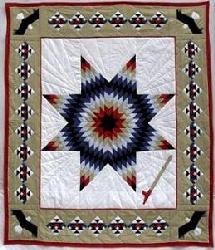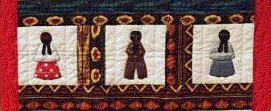America's Quilting History
The Diversity of Native American Quilts

Native Americans represent several diverse cultures from different regions and with varied histories. Each culture is rich in symbolism that is represented in artwork ranging from woven Navajo rugs to intricate beading on leather. As settlers and soldiers moved west they brought quilts with them. Native Americans were fascinated with these new bedcoverings. Quilting was also introduced to Native Americans by missionaries who sought to "civilize" the natives by teaching them traditional European homemaking skills. Native American quilters soon found creative ways to incorporate their own cultural designs into their quilts.
One example is the Morning Star design that Plains Indian women adapted in the late 1800s from the traditional Lone Star pattern. These native plains people were keen observers of the Morning Star (Venus) and already used representations of this star in paintings on hides and in beadwork. Morning Star quilts are made with an eight-pointed star that fills most of the quilt top. Numerous small diamonds are skillfully pieced together to create these stars. Native American women from the Great Lakes regions added floral motifs from their own traditions. These appliquéd flowers were placed between the points of the stars. The Morning Star pattern is still a favorite today and is often used as a gift for special occasions.
Seminole quilting originated from the Seminole patchwork used for clothing by these southeastern Native Americans. In the late 1800s it was a long trip from the Everglades to trade for cotton cloth so women began sewing strips made from the fabric left on the end of the bolts to make what was know as "strip clothing". The sewing machine became available to these women around the turn of the century making it possible to use much smaller strips. Seminole designs grew to become even more elaborate and complex. Seminole patchwork was usually used for traditional dress including the women's long full skirts and big patchwork shirts worn by the men. Even today these garments are worn for special occasions. These beautiful Seminole patchwork patterns eventually become popular in quilt making as well.

Southwestern Native Americans have incorporated designs from sand paintings, woven Navajo blankets, basketry and other symbolism into their quilts bringing still more beautiful adaptations of traditional designs into the making of quilts.
Hopi quilters today are using pottery designs in various ways on their quilts. The painted block pictured here is by Bonnie Nampeyo Chapella great great granddaughter of the famous Hopi potter Nampeyo. The Hopi Baby-Naming ceremony is a good example of old ways evolving into the use of quilts. Quilts have come to replace a single woven blanket as gifts during this ceremony. Pearl Nuvangyaoma is a skilled Hopi basket maker but her other love is the making of quilts. View her Nine-Patch Quilt made with fabric contributed by churchwomen. Although sometimes she quilts using patterns more often, she tells us, "You just put the fabric scraps together as you get them and you don't plan the colors. That is the old-fashioned way." 1 Although she has sold some of her quilts most have been baby quilts going to Hopi children.
Native American artists have turned to quilting as a media bringing us some stunning scenic quilts with cultural motifs. Take a look at "Coyote Helps Create the Night Sky" and "A New Time" to see examples of the artistry of two Native American quilters.
While it is interesting to look at the cultural connections in Native American quilting we need to be aware that a great many of the quilts made are the same patterns and styles that American women in general have been making over the years. In fact Native American women quilt for much the same reasons as other women quilt; as wedding gifts and baby gifts, for family use, to raise money for organizations, for personal satisfaction and in some cases to sell. Some prefer quilting alone while others enjoy quilting with others. As quilt historian, Jill Hemming, points out, "Just as there is no quintessential 'African-American Quilt' there is no definitive 'Native American Quilt' —no matter how hard scholars may be looking for it." 2

It may not be so much the kind of quilts made as the use of quilts as gifts that reflects Native American culture. The giving of gifts is an important part of Native American communities. Gifts are given at baby-naming ceremonies, pow-wows, graduations, funerals, and for athletic achievement. Quilts are even made to honor veterans. It is significant that quilts are common gifts at these events. These Native Americans have not only embraced the art of quilting, expanding it both in design and form, but they have also demonstrated to all of us that the gift of a quilt is indeed a perfect gift.
© 2001 Judy Anne Johnson Breneman (Do not reproduce any material from this site without permission.)References:
1 p248 "In the Old Way: A Visit With a Hopi Quiltmaker", by Carolyn O'Bagy Davis, Quilter's Newsletter Magazine, July/August 2003
2 p202 "Waccamaw-Siouan Quilts: A Model for Studying Native American Quilting", by Jill Hemming, Uncoverings 1997
"To Honor and Comfort: Native Quilting Traditions", by Marsha MacDowell (Editor), C. Kurt Dewhurst (Editor)
"Hopi Quilts", including a Painted Pottery Quilt by Bonnie Chapella
"The Grandest Quilted Star of All", Star of Bethlehem, Morning Star, & Lone Star Quilt
The above star quilt picture is from "Diane's Native American Quilts" Be sure to visit this site to see more wonderful Native American star quilts.



